 In the world of foraging, few organisms conjure up fear and mystery more than mushrooms. Tell someone you harvest wild berries, and he thinks to himself what a great hobby. Tell another person you hunt wild mushrooms, and she fears for your life.
In the world of foraging, few organisms conjure up fear and mystery more than mushrooms. Tell someone you harvest wild berries, and he thinks to himself what a great hobby. Tell another person you hunt wild mushrooms, and she fears for your life.
“Aren’t you scared?”
“What if it’s poisonous?”
“I could never pick wild mushrooms, they’re much too dangerous.”
The fungal kingdom, it seems, is a bit of an enigma. In 1991, a paper was published suggesting that, although 1.5 million fungi were thought to have inhabited the earth, only about 70,000, or 4.7%, of fungal organisms were identified at that time (1). Today, it is estimated that there are 5.1 million fungal species in existence, and the number of identified species is still quite small in comparison.
It’s true, out of 5.1 million fungal species, some of them are quite toxic. Destroying Angel, Deadly Galerina, and Death Cap aren’t just fancy names, though they may or may not be hit singles from late 80’s heavy metal bands…
It’s easy to focus all our attention on the dangers of wild mushroom hunting, and of course the risks are valid concerns. One must absolutely know what he or she has in hand before even thinking about pulling out the butter, salt, and frying pan.
There is another side to wild mushroom hunting, however. The medicinal side. The healing side. The delicious side.
Obviously, several mushrooms are edible. A quick trip to the grocery store confirms this. Many individuals are interested in going one step further by foraging edible mushrooms, yet have no idea where to start. It can all appear quite daunting at first, especially after realizing you’re dealing with 5.1 million potential species (okay, this is an exaggeration; much of this large number does not pertain to mushrooms in their fruiting body stages, but rather to microscopic fungi, such as yeasts and molds).
So where do we start?
Well, why don’t we begin with the most easily identifiable wild edible mushrooms? You know, the ones that when you see them you think, “Yep, that’s exactly it!”
In this post, I have put together a list of 5 easy-to-identify edible mushrooms. These mushrooms are fairly conspicuous, they’re delicious, and they require a hefty stretch of the imagination to misidentify as toxic look-alikes.
Note: I live in western Pennsylvania. This list, therefore, is based on my experiences with the organisms in this area.
1. Lion’s Mane (Hericium erinaceus)

Not all mushrooms look like the portobellos and the shiitakes found in the grocery store. Lion’s Mane, for one, certainly does not. It is one of the most unique-looking mushrooms, with its unbranched body of icicle-like spines and soft white tissue. Accordingly, Lion’s Mane is a great mushroom for beginning mushroom hunters.
The fruiting body of Lion’s Mane consists of an unbranched, cushiony, water-rich mass that is between 3-10” wide and typically the same size tall. Lion’s Mane is the only Hericium species in eastern North America that is unbranched. The fruiting body of Lion’s Mane consists of numerous, icicle-like spines (“teeth”) that point downward and taper to a point. Each spine is soft and typically half-an-inch to 2 inches in length. These spines are white when young and yellowish when older.
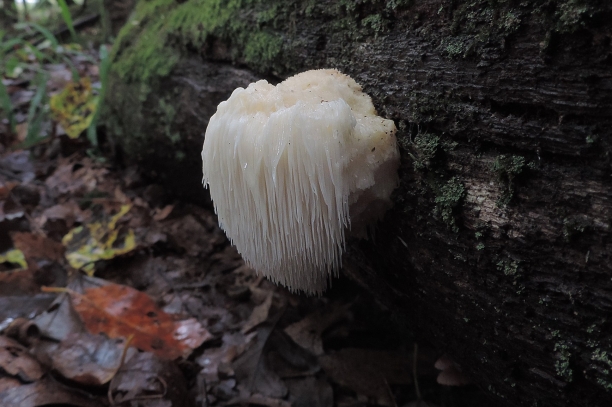
The spore color produced by Lion’s Mane is white.
Very few mushrooms resemble Lion’s Mane, and the ones that do are taxonomically placed in the same genus (Hericium). These include Bear’s Head (H. abietis), Coral Tooth (H. coralloides), and Bear’s Head Tooth (H. americanum), among others. What distinguishes Lion’s Mane from its relatives are its long spines (1-4 cm long) and unbranched fruiting body. All species of Hericium are considered to be edible.
Also known as the Pom-Pom mushroom, Lion’s Mane is one of the most delectable mushrooms in the fungal kingdom, resembling crab meat in taste and texture. Additionally, Lion’s Mane has been well researched for its role in improving cognitive health, producing neuro-regenerative effects in numerous studies (2, 3, 4).
Look for Lion’s Mane on the wounds of living hardwood trees, such as oaks and maples, as well as on recently felled trees. It can be found in the summer months through autumn.
2. Chicken Of The Woods (Laetiporus sulphureus)
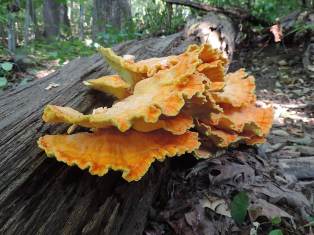
While Lion’s Mane is one of the easiest mushrooms to identify, its presence is a bit more rare than some of the other choice edibles. Take Chicken Of The Woods, for example. Once you develop a search image for this fungus, you’ll start seeing it everywhere (okay, maybe not on Mount Kilimanjaro, but you get my point).
Chicken Of The Woods (also known as the Chicken Mushroom or Sulphur Shelf) grows in clusters on both standing and downed trees, emerging as knob-like growths and soon developing into numerous shelves.
Each individual cap can be up to 12” wide, though oftentimes you’ll find individual caps that are much larger than this. The top of the mushroom is typically smooth and faintly wrinkled, and when fresh, its color is bright orange to yellowish orange (sometimes with a bright yellow margin).
With age, the caps of this mushroom will fade and turn whitish and become very crumbly. However, if you find Chicken Of The Woods at this stage, check that spot again in a few months or next year, because this mushroom tends to fruit multiple times on the same log or tree.
Chicken Of The Woods is a polypore mushroom because its fertile surface (underside) contains numerous pores from where the spores are dispersed. This means that there are no gills on the underside of Chicken Of the Woods, and there will never be gills on the underside. This mushroom always contains a pore surface with very tiny pores.
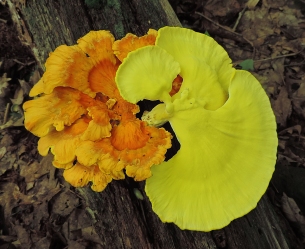
In this particular species, Laetiporus sulphureus, the pore surface is bright yellow when fresh, though this color will fade with age.
Note: The closely related L. cincinnatus contains a peachish-orange cap and a whitish-peachish pore surface. It, too, is edible.
The spore print produced by Chicken Of The Woods is white.
The texture of cooked Chicken Of The Woods resembles… get this… chicken, and this mushroom is best collected when young. As it ages, this mushroom becomes too tough to eat, though the outer edges can still be salvaged and used in dishes. Like all wild mushrooms, it requires cooking before consumption.
Beyond edibility, Chicken Of The Woods is medicinal as well. Research has shown that an extract from this mushroom possesses antimicrobial activity against the pathogen, Aspergillus flavus (5). Chicken Of The Woods is also a great source of antioxidants, including quercetin, kaempferol, caffeic acid, and chlorogenic acid (6), and it contains lanostanoids – molecules that have the ability to inhibit cancerous growths (7). What more could you ask for from a humble saprophyte?
Look for Chicken Of The Woods in the summer months through autumn. To learn more about this fantastic fungus, I encourage you to check out a video I created on its identification, look-alikes, medicinal benefits, and more.
3. Hen Of The Woods / Maitake (Grifola frondosa)
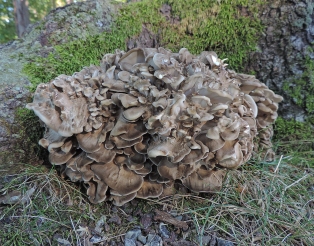
The Maitake mushroom (also known as Sheep’s Head or Hen Of The Woods) is a choice edible and medicinal that always demands a good hunt. While it’s easy to identify and widely distributed, Maitake can be somewhat tricky to locate compared to the showy Chicken Of The Woods, as the former blends in well with the autumnal foliage.
Maitake contains overlapping gray to brown caps attached to a single base. Each cap is between 1-3” wide and typically fan-shaped and fleshy (not woody like you’ll see in other polypores).
Underneath each cap is a pore surface containing numerous tiny pores. There are no gills on the Maitake mushroom… just a pore surface. The pore surface is whitish or light gray in color, and these pores do not bruise when handled or scratched.

The spore print produced by the Maitake mushroom is white.
While not difficult to identify, Maitake may resemble other non-toxic polypores. The Black Staining Polypore (Meripilus sumstinei) bruises black and can be found growing on buried wood. Young specimens are edible, though they become too tough to consume with age. The Umbrella Polypore (Polyporus umbellatus) is another edible look-alike which contains white to grayish caps, though this mushroom is multi-branched and not as common.
Maitake compliments a variety of dishes, lending a hearty flavor and tender texture. In addition to its use as a food, Maitake has been researched extensively for its medicinal properties, specifically in the areas of cancer and diabetes.
Maitake, with few look-alikes, is certainly one of the safest mushrooms to harvest. Look for this gem under oak trees (and make sure you circle the tree … you may be pleasantly surprised to find a second or third), late summer through autumn.
To learn more about the Maitake mushroom, I encourage you to check out this video I created on its identification, health benefits, and more!
4. Oyster Mushroom (Pleurotus ostreatus)

Oyster mushrooms are popular amongst both mushroom hunters and cultivators. To positively identify Oysters, one only needs to visit a grocery store and observe these mushrooms in bins or clamshells.
Still, many features ought to be noted before harvesting Oyster mushrooms in the wild, and once learned, you’ll have easy access to wild fare many months of the year.
Oyster mushrooms are edible fungi that grow in overlapping clusters on wood… usually on hardwood logs, stumps, and standing dead trees. Rarely will you see this particular species, Pleurotus ostreatus, decomposing conifer wood… though it is possible.
Each cap is typically between 3-8” wide and shaped like an oyster. While many Oyster mushroom species are white, Pleurotus ostreatus can be cream-colored and even grayish-brownish in color.
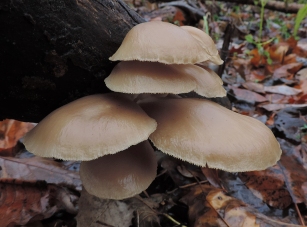
The underside contains whitish gills that become yellowish in age. A key feature of Pleurotus ostreatus is that its gills are decurrent; in other words, the gills run the complete length of the cap and down the stalk.
The spore print of Pleurotus ostreatus is pale-lilac to whitish.
Pleurotus ostreatus is unique in that it tends to grow in the colder months of the year — mid-autumn, all the way through winter, and even into early spring. If you’re finding an Oyster mushroom during these colder months, and its color is tannish, grayish, or brownish… there’s a good chance you’re looking at Pleurotus ostreatus.
To learn more about oyster mushrooms, check out this video in which I discuss identification, medicinal benefits, and more.
5. Morels (Morchella sp.)
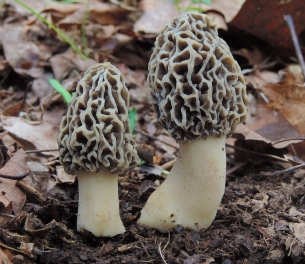
Morels (genus Morchella) are among the most prized of all wild mushrooms. Every year, countless mycophiles scour the woods in search of these tasty, elusive fungi.
Mushrooms within the Morchella genus belong to one of 3 groups (“clades”):
- Black clade (elata)
- Yellow clade (esculenta)
- Rufobrunnea clade (which currently contains the species Morchella rufobrunnea, a Morel that appears in woodchips and landscaping settings on the West Coast from California to Seattle.)
Black Morels (in the elata clade) typically appear first. Depending on where you live, you might see Black Morels in March. These mushrooms grow terestrially underneath a variety of trees, including ash, sycamore, aspen, and coniferous trees, and are most commonly found in Northern and Western North America (though they certainly do grow in Eastern North America). Disturbed areas are good places to look, including campgrounds, along roads, and in logged areas.

Black Morels can be found in burned areas as well, especially 1 to 2 years after the occurrence of a forest fire. Additionally, wetland areas can be conducive to Black Morel mushroom fruitings, especially in lowlands containing sycamore and cottonwood trees.
Yellow Morels (in the esculenta clade) are more common in Eastern North America and in the Midwest (though they do grow in Western North America). They grow near a variety of hardwood trees, including tulip poplar, ash, and dead or dying elm trees. Older apple orchards are also good places to look.

Of course, these are generalizations for both groups. Yellow Morels grow in burned areas, too. Black Morels may be found under tulip poplar trees. I have simply narrowed down the descriptions to what is most commonly observed. There will always be outliers.
Regardless of clade, Morels generally demonstrate these physical characteristics:
- Honeycomb-pitted caps made up of a series of pits and ridges.
- Entire mushroom (cap and stem) is hollow from top to bottom. This feature is easily observed when each mushroom is cut in half lengthwise.

These features, once learned, will help you clearly separate “true” Morels from their look-alikes, including false morels, thimble morels, and stinkhorns. False morels of the genus Gyromitra tend to retain a darker shade of red and have a wrinkled, brain-like, or convoluted cap. A few mushrooms in the Gyromitra genus are known to be toxic (to a degree). Thimble morels (Verpa spp.) have free, “skirt-like” sides, and stinkhorns (Phallus spp.) have a sack or volva at the base and are generally quite foul-smelling.
For more information on finding and identifying morel mushrooms, check out a very detailed article on this blog: How To Find And Identify Morel Mushrooms
If I had to include additional easy-to-identify mushrooms, I would extend this list to boletes, chanterelles, puffballs, and shaggy manes. The ones that made the final cut, however, are those that I have found to be the easiest to identify. I hardly need to think twice before bringing these delectable fungi home.
The mushrooms that earned their ranking are also the ones that, when taught to other beginning mushroom hunters, are identified with confidence and ease. If you are just starting on the road to becoming an ardent mushroom hunter, use this list as a guide for helping you along your journey. Remember, however, that the descriptions here are not complete and are only meant to briefly discern the listed mushrooms from their potential look-alikes.
A good habit (actually, an extremely wise habit) is to cross-reference your mushrooms with other resources, and always be absolutely positive with your identification before ingesting wild mushrooms in any form. Your safest bet is to have an expert identify, or confirm the identification of, your specimens. A quick online search will yield local mycologists as well as online forums to assist in the identification process.
There, that eases the fear of wild mushroom hunting just a little bit, wouldn’t ya say?
Thanks for reading, and as always … happy foraging!
Let’s stay in touch! To receive information from Adam Haritan on wild plant and mushroom identification, please enter your name and email address below. Thank you!
Additionally, don’t forget to check out the Facebook and Instagram pages to learn more about wild food nutrition and identification!
—Adam Haritan



Very enjoyable read. thank you
Wow..how i would love to learn mushroom identification but i live in city..are there edible mushrooms right in my front yard? Im so scared of identification since i am new to this.
Does the oyster like mushroom harden to the trees if it drys out on the tree.
No… they die, far too much moisture in them.